Sweet Crude on the Seashore
The Past, Present, and Future of Goleta's Oceanfront Oil Facility
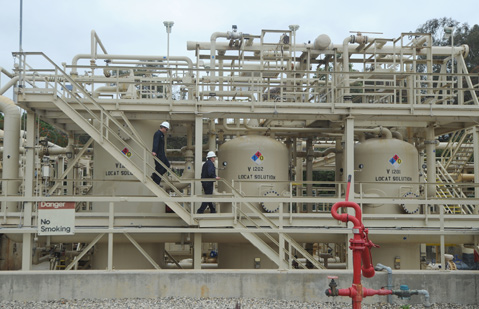
Tucked in a coastal canyon between the sands of Haskell’s Beach, the Bacara Resort, and Sandpiper Golf Course is the oil and gas processing plant known as the Ellwood Onshore Facility (EOF), which treats the flow of fossil fuels being collected by Platform Holly from deep beneath the ocean floor and sent to shore every second of the day. Although today’s design first came about in the 1970s — predating both the resort and the golf course — the facility is a stark reminder of an earlier era when much of the Santa Barbara coastline was an industrialized shoreline, a landscape of drill rigs that stretched from Ellwood to the top of S.B.’s Mesa and down past Summerland.
With Goleta growing around it, the EOF is the closest thing we have to a neighborhood oil facility, but whether it’s friendly or frightful is the topic of a decades-old debate. On one hand, it provides high-paying jobs for workers, both blue-collar and wing-tipped; pumps millions of dollars to the state in royalties and many thousands more via philanthropic donations; and powers the fossil-fuel-addicted world we live in, processing enough oil and gas daily to support the needs of about 60,000 Americans and 13,000 homes. On the other hand, with the potential for poisonous gas leaks, fiery explosions, and oil spills along the environmentally sensitive oceanfront, it’s a risky workhorse to have amid the tourists, golfers, nearby residents, and Ellwood Elementary School, less than a mile away.
It’s no wonder, then, that since the 1980s there have been numerous efforts to fence in the EOF — from the County of Santa Barbara officially dictating in 1991 that it does not conform with the surrounding recreational properties (and again by the City of Goleta when it formed more than a decade later) to the voters passing a measure in 1997 that dictated all “new” oil and gas processing on the South Coast should be handled by the Las Flores facility, which is nine miles up the Gaviota Coast more safely secured in a canyon.
In the late 1990s, shortly after Venoco Inc. acquired the facility and platform from Mobil, a series of leaks fanned the rancor loud enough that the county examined what it would take to shut down the EOF and when. The conservative answer to the latter question, though couched in myriad variables and unknowns, was 2016, which seemed a long way off when it was announced in 2001.
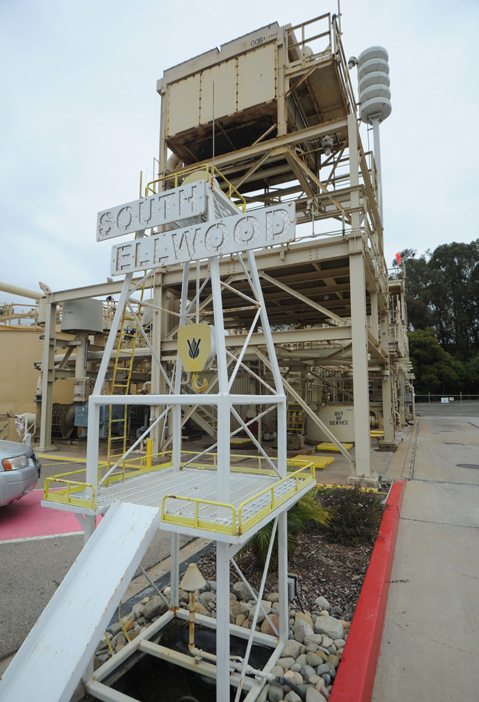
But now it’s 2014, and thanks to breakthroughs in “enhanced recovery” techniques (e.g., hydraulic fracturing, a k a fracking, and acidization), there’s more oil to find than ever before, and due to insatiable global demand, it’s never fetched a higher price. So Venoco won’t be walking away from the EOF in 2016. Instead, it’s hoping to pump more oil from a nearby pier through the facility, has expressed interest in expanding its offshore lease, and is saying it’d prefer to stick around for another 40 or so years.
There is a slow tide rising against such hopes, however. Just last week, the Goleta City Council sent a strongly worded letter to the State Lands Commission in opposition to the proposed pier project (approval was expected this week, but the commission demanded more environmental review on Wednesday afternoon). For the first time in years, the Goleta hearing’s speakers, including a couple of councilmembers, discussed the possibility of ending the EOF through amortization, the complicated process for government to shut down an unwanted facility. The logistics of amortization is what the county studied in 2001 and then passed to Goleta decision makers when the city incorporated it in 2002. At that time, the young city had no inclination to dive into an expensive, probably litigious, and assuredly controversial process of ousting one of its most successful businesses. Today, there may be at least the political will to dust off that old study and pay for an updated one.
Toward the end of the hearing, Mayor Michael Bennett — who is considered a pro-business Democrat but is vehemently anti-EOF, like the vast majority on that dais — recalled dreaming of taking his granddaughter to the Ellwood Coast when the facility was removed. “It’s probably going to be my great-granddaughter that I take out there to the beach as opposed to my granddaughter,” said Bennett. “That is certainly my hope and my desire and my vision that this will be a formidable recreational area in my lifetime.” Given that he’ll turn 66 this June, Bennett may be hitting the century mark before he takes that walk, unless someone takes bold action to recalibrate Venoco’s vision of the future.
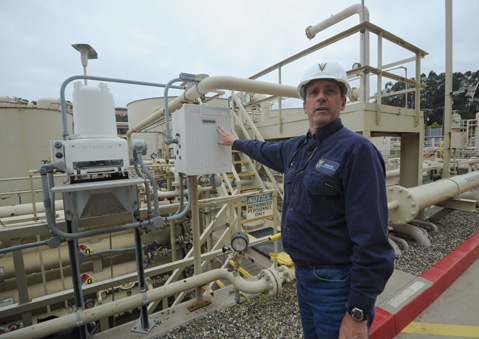
Operation Explanation
Today, offshore rigs work in ocean waters more than 8,000 feet deep, but when Platform Holly was erected in 1966 in 201 feet of water, it was a “worldwide wonder,” according to Bob Van Nostrand, the senior facilities engineer who oversees daily operations at the EOF. Located two-and-a-half miles offshore in waters that are naturally slicked with tar and bubbling with methane, Holly’s initial target was the geologic structure known as the Rincon formation, which contained a lighter grade of oil and gas that was exhausted by the 1970s. By then, the Monterey shale was discovered, so Holly started extracting that formation’s thicker resources from a spider’s web-like assortment of shallower wells, and the EOF was expanded to deal with the increased, more complicated flow. But don’t be fooled into thinking that the Monterey offers low-quality sludge, as is often claimed by critics. “It’s actually one of the better grades of oil,” said Venoco’s vice president of Southern California operations, Ian Livett, of its premium viscosity. “This is like lager, if you think about it that way. This isn’t Guinness.”
Each day, the EOF — which is a maze of sandstone-colored pipes with occasional streaks of yellow and red, populated mostly by burly men in jumpsuits and hard hats — processes 4,000 barrels of oil and 2.5 million cubic feet of gas per day. When the materials emerge from the seafloor, the gas and some water are separated from the crude on Platform Holly, the water is reinjected into the well, and the resulting oil and gas are sent to shore in two separate pipelines, each six inches wide and snaking 15,000 feet along the ocean’s bottom. (A third pipeline, with ready-to-burn natural gas, also goes back out to the platform from the EOF to power it.)
Once at the EOF, the gas is converted into a usable form and sent straight to market, possibly powering your water heater right now. The oil is cleaned up to become a sweet crude, then piped nine miles up to Las Flores, where it might go north to a refinery in Santa Maria and into the Plains All American Pipeline, or south to refineries in Los Angeles.
For decades, the EOF also treated the methane that was captured by ocean-floor “seep tents” off of Coal Oil Point, but those vents mysteriously ceased their bubbling in August 2013. That’s about the time that Venoco stopped taking folks out on boat tours to check out the other seep-related slicks because it can’t find them anymore. Theories abound as to why.
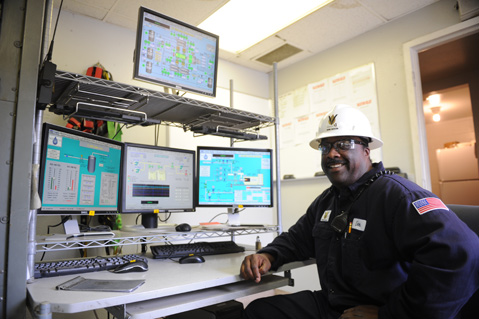
Though Venoco processes substances, the offshore oil is technically owned by the state of California, which is why the State Lands Commission controls the access and reaps the royalties, amounting to about $25 million per year from the Ellwood field alone. The platform and EOF are subject to a wide range of regulations and regulators on the state and local level, and Venoco proudly touts its multiple awards for safety and track record for community engagement, through which it has eased concerns of neighbors, whose complains about bad odors often turn out to be caused by sources other than the EOF.
“We want people to know we are very, very, very responsible operators,” said Livett, while showing off awards for “Outstanding Lease Maintenance” bestowed upon Venoco by the State Department of Conservation. “Oil and gas is nasty stuff; it’s dangerous stuff, and I’m not going to say that we never do anything wrong. But we are exemplary in our procedures.” The latest reports available on the Internet confirm as much, although accidents do happen, such as the three barrels of oil that spilled at the EOF on March 29, causing a brief shutdown of the plant and immediate cleanup.
Until 2012, Venoco ran the last oil-barging operation in California through the Ellwood Marine Terminal (EMT), in which every 11 days, the Jovalan would tie up to a rubber hose that floated offshore of those big tanks near Devereux Slough, fill its hulls with 56,000 barrels, and travel either north or south depending on where the oil was needed most. After years of discussion and permitting — and with UCSB not offering to renew its lease on the tanks past 2016 — Venoco built a nine-mile pipeline to Las Flores and is now working on a plan to dismantle the entire EMT.
Today, Venoco contends that ending the barging and creating the pipeline was its desire all along. “We make much more money with that pipeline,” said Livett. “It’s a godsend to us.” But that claim makes other people laugh out loud. “Oh my gosh,” said Linda Krop of the Environmental Defense Center (EDC), which argued for the pipeline for years. “They fought that very vociferously.”
Venoco appreciates that its award-winning track record is, in part, because it was born and raised in a Santa Barbara community filled with enviro-watchdogs whose steady pressure has resulted in strong oversight. The company even speaks in strong support of conservation and alternative fuel sources. Still, there’s no love lost for the environmentalists who harangue them constantly. They’re more anti-oil than pro-environment, said Venoco spokesperson Lisa Rivas, who argues that drilling near home is less damaging than relying on oil from afar and thinks the further regulation of techniques like hydraulic fracturing is more likely to impede production than save the world.
“The anti-oil groups are trying to thousand-death-cut us,” said Rivas, who admits it can be “uncomfortable” not being liked by your neighbors. “No amount of conservation and efficiency should be discounted, but it still does not address the bigger picture that we often forget about when we look at our coastline: Oil being tankered in from foreign lands is the biggest impact of all.”
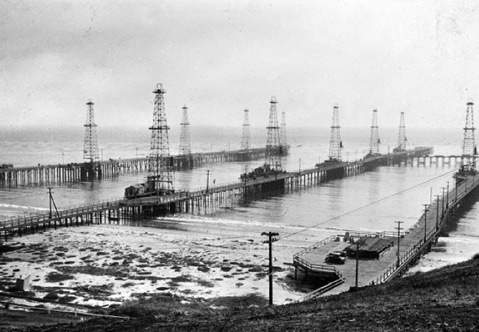
Oily Earth Day Roots
The Santa Barbara oil spill of 1969 birthed the modern environmental movement — including the Earth Day celebration, which takes place this weekend in Alameda Park (see the Earth Day Festival insert for the program) — and oil companies with their very visible offshore rigs remain the Goliath being fought by legions of Davids, who battle under the banners of the Environmental Defense Center, Get Oil Out!, Surfrider, and numerous other nonprofit and community organizations. For many of these activists, the EOF is the bull’s-eye in an endless game of get-oil-out darts.
“We recognize that when the plant was built, it was pretty much way out there, surrounded by nothing,” said Krop of the EDC, which has waged a loud legal war against oil since its founding in the early 1970s. “But now there are a lot of residential and recreational uses in that area, and it really is incompatible. There are better places for you to process oil and gas.”
Venoco knew it was buying a nonconforming facility in 1997, argues Krop, and it also knows that Santa Barbara County voters voted in favor of consolidating such processing at Las Flores, so why doesn’t it just go there? Venoco claims that’s not really possible; that beyond the added expense and lost income of not processing itself, Exxon’s Las Flores facility does not have enough capacity; that it would require an expansion; and that it would mean a nine-mile pipeline full of sour, untreated, more-toxic oil and gas rather than the clean stuff now coming out of the EOF.
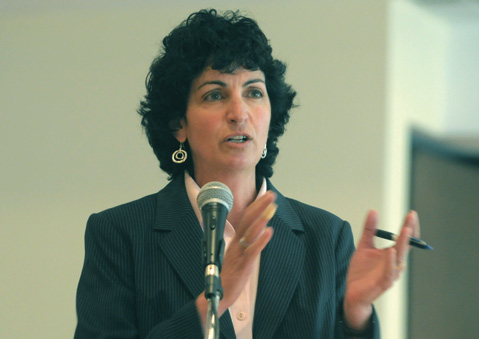
When contacted, an Exxon spokesperson declined “to speculate on future business matters,” but Krop doesn’t trust Venoco anyway and sees them as dirty dealers. She points to Venoco’s 2010 attempt to go around Carpinteria’s City Council process by putting the idea of a new, centrally located oil rig in the beach town to the voters. (Venoco maintains that its polling showed support for the project, known as Paredon, and that it was too big of a decision to leave up to just the councilmembers alone.) The voters resoundingly rejected it, nearly three to one.
Venoco complains that getting new projects approved is tough, but getting rid of existing oil projects is even harder. Industry-wide, it’s shocking what companies will do to avoid having to pay for shutdown costs, even when wells have stopped producing. It’s cheaper to run a rig at one percent of the expected flow than pay the many millions to tear it down, and when that time inevitably comes, the corporations have been known to form companies with no assets, transfer dead rigs to the new company’s holdings, and then walk away, leaving no funds, other than perhaps taxpayer money, for dismantling.
The County of Santa Barbara is trying to combat that maneuver by forcing abandonment plans to be created when a rig gets to the 3-percent-of-flow mark, but tracking and enforcing that is a nebulous chore. Altogether, the oil industry boasts way more resources, precedent, and protection than a small city like Goleta or even Santa Barbara County for that matter, and the EOF is only the tip of that iceberg.
“One hundred years from now, are people who live in Goleta still gonna be looking at Platform Holly?” asked Fran Farina, an attorney working on coastal issues for the Sierra Club’s Los Padres chapter. “That’s what we’re dealing with. Nothing in this state has an end date. When you see an estimated production of 20-30 years, it means nothing. It’s like getting rid of oil in this community is impossible.”

The ‘A’ Word
A word whose root means essentially “to kill,” amortization is the uniquely American process of a government entity forcing an unwanted operation to close after the owner has achieved a reasonable return on the initial investment and also covered associated costs of the shutdown. Emerging out of the first zoning ordinances in 1916, which allowed certain preexisting sites to be labeled nonconforming, amortization was most often used in the initial decades for removing ugly billboards along the country’s growing highway system. Taking down signs, of course, is much more simple and affordable than applying the law to an oil facility.
“There is no universally accepted approach,” according to a rather poetic 1990s report on the practice by Margaret Collins. “The process of determining amortization periods is not merely a matter of accountancy; it is rather a ‘balancing test’ weighing the private cost against the public gain,” she wrote, explaining that it’s really “more of a postponement than a solution,” that “it has the virtue of cushioning the economic shock” through the “vice of delay,” and that it’s “more art than science.”
Governments tend to be more engaged in science than art, so while nonconforming sites occur from sea to shining sea, amortization is not commonly employed. When applied to profitable entities that don’t want to leave, it’s expensive — in large part because the process tends to wind up in court, for companies don’t usually roll over — and, for a country that prides itself on private-property rights, wildly controversial.
The ball rolled ever so slightly toward the idea in the county’s 2001 study by the Houston, Texas, firm Baker & O’Brien. While explaining that the variables were myriad — especially when it came to the fluctuating price of oil and improving extraction techniques — the study concluded that it would cost $34 million to move the operation to Las Flores and another $35 million to shut down Platform Holly one day in the future and that those costs would be properly amortized over about 15 years. The study also laid out how to do so by first passing a general ordinance about removal of all nonconforming facilities and then employing that on the specific facility.
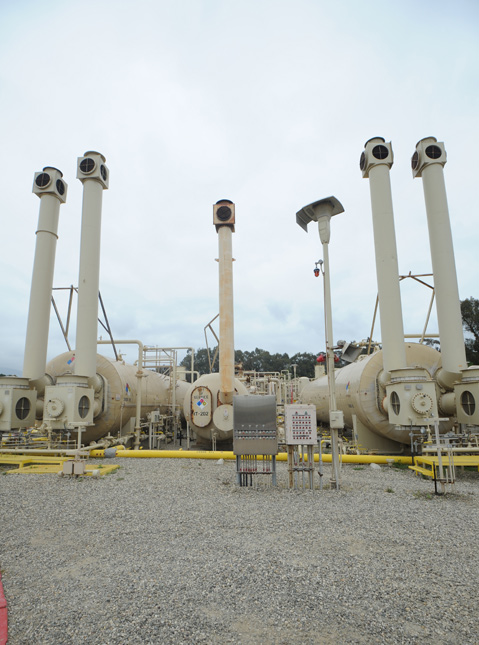
Back then, Venoco cited legal decisions related to the mining industry to argue that its vested rights to extract the oil beneath Platform Holly depend on the EOF; it’s singing a similar tune today. “It’s still a necessary facility,” said Rivas, remarking that amortization is simply “not an option.” It will fight any amortization attempt with all of its considerable might, now believing it could keep going past 2050, and it would at least have the support of the Goleta Valley Chamber of Commerce, whose director Kristen Miller opined, “This is a small business in our town in a legal industry doing a legal business, and there are property-rights issues.”
As of last Friday, while the “a” word was once again ringing in the wings of Goleta City Hall, no one from there had actually reached out to Baker & O’Brien. When contacted, the company’s Don Flessner said they would be “very interested” in updating the study (which cost $170,000 in 2001, plus another $60,000 in county staff costs), explaining that it’s a wildly different world now with high prices and enhanced recovery techniques. He then asked for (and was provided with) contact info for a point person in the city.
Given the challenges, former Goleta city councilmember Margaret Connell doubts amortization is the silver-bullet solution. “It’s more a matter of controlling what we’ve got rather than getting rid of it,” said Connell. “They’re a company who is very generous with the community, but they’re in a dirty business. Everybody just has to watch them and be vigilant.”
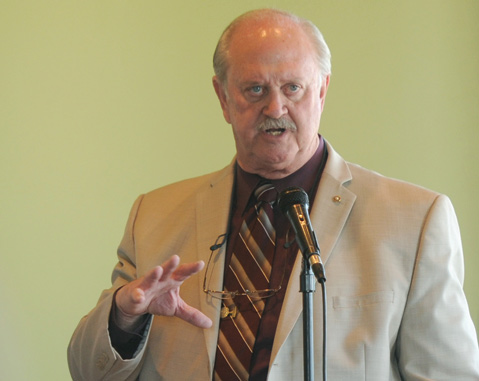
Paradoxically, the key to shutting down the EOF may be letting it expand production first. If Venoco pursued the dream of expanding its offshore lease, for instance, the City of Goleta might have enough leverage to make a deal for eventual shutdown of the plant and potentially the platform, as well. But there’s plenty of risk, as deals made by today’s politicians can be broken by tomorrow’s. Or, as in the case of the proposed Tranquillon Ridge deal from years back, in which a number of rigs off of Vandenberg Air Force Base were going to be allowed to expand in exchange for eventually shutting down, Sacramento politicians can scuttle what many locals considered a pretty sweet deal.
In the meantime, it remains to be seen whether Goleta Mayor Michael Bennett will ever take that walk with his great-granddaughter. He remains steadfast, though, explaining, “I will do everything within my ability to push whoever I need to push to get them out of town.”




